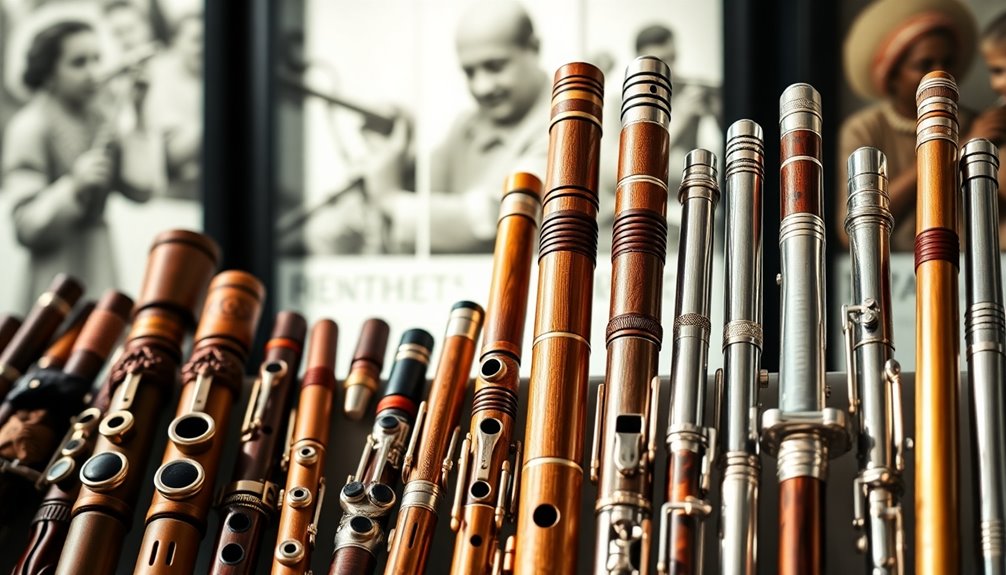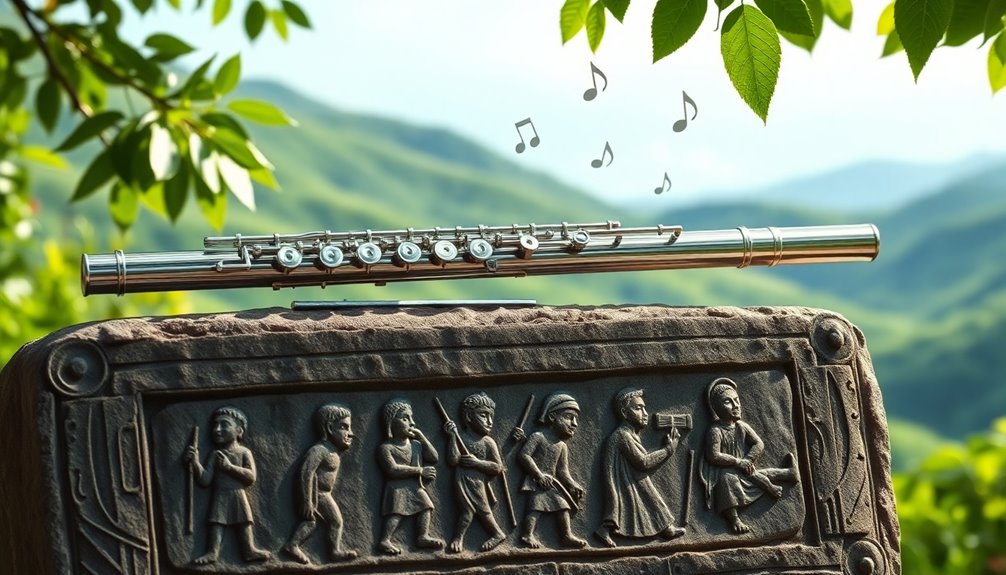The flute's history stretches back over 35,000 years, reflecting its significance across cultures. You'll find ancient flutes made from bone, wood, and bamboo, often tied to spiritual rituals. The Renaissance advanced flute design, while the Industrial Revolution introduced metal and the Boehm system, enhancing playability. Key figures like Theobald Boehm and Jean-Pierre Rampal redefined the instrument's role, expanding its repertoire in both classical and popular music. Today's flutes offer a warm, versatile tone that complements various genres, continuing a legacy of connection. To grasp the full impact of the flute's evolution, there's much more to explore.
Key Takeaways
- The flute has ancient origins, with early versions made from bone, wood, and bamboo, dating back over 35,000 years.
- The design evolved through the Renaissance and Baroque eras, leading to the transverse flute becoming a staple in orchestras.
- Theobald Boehm's 19th-century innovations improved flute design with the modern key system, enhancing intonation and playability.
- Modern flutes, crafted from higher-grade materials, produce a warm tone suitable for diverse musical genres, including orchestral, jazz, and pop.
- The flute's historical journey reflects a blend of tradition and innovation, fostering a global music community and cultural expression.
Ancient Origins of the Flute

Although the flute's modern incarnation may seem far removed from its ancient predecessors, its origins trace back thousands of years to various cultures around the globe. The earliest forms of the flute are classified as prehistoric instruments, often crafted from materials like bone, wood, and bamboo. These primitive flutes, discovered in archaeological sites, offer a glimpse into the musical practices of ancient civilizations.
In Europe, for instance, flutes made from bird bones date back to around 35,000 years ago, showcasing an early human desire for musical expression. Similarly, in China, flutes made from hollowed reeds have been found in tombs dating back to the Shang dynasty, indicating their significance in cultural rituals and daily life.
These instruments weren't merely tools for entertainment; they were deeply intertwined with spiritual and communal practices. As you explore the origins of the flute, consider how it served as a bridge between people, fostering connections within ancient communities. The sounds produced by these early flutes likely accompanied storytelling, ceremonies, and social gatherings, enriching the fabric of life in ways that resonate even today. Each note carried the weight of tradition, marking significant moments and shared experiences.
Understanding these ancient roots helps you appreciate the flute's evolution and its enduring place in music history. As you investigate the past, you'll find that the flute is more than an instrument; it's a reflection of humanity's timeless quest for connection through sound. The Western concert flute has since become the most common type of flute in orchestral settings, showcasing its long-lasting impact on music culture.
Evolution Through the Ages

The flute has undergone remarkable transformations through the ages, adapting to cultural shifts and technological advancements that shaped its design and usage. In ancient times, simple wooden and bone flutes were common, primarily featuring a straight construction with minimal embellishments. As you investigate the development of the flute, you'll notice how these early instruments laid the groundwork for more complex designs.
During the Renaissance, flute construction evolved considerably. You'd find flutes made of wood with multiple pieces, allowing for a more refined sound and greater range. This period also introduced new musical techniques, such as vibrato and ornamentation, which added expressiveness to performances.
As the Baroque era emerged, the transverse flute gained popularity, and it became a staple in orchestras, further pushing the boundaries of flute playing.
The Industrial Revolution brought about profound changes in flute construction. Metal flutes, particularly those made of silver, became prevalent, providing durability and a brighter tone. This change also allowed for the development of key mechanisms, enabling musicians to explore more complex musical techniques and expand their repertoire.
The Boehm system, introduced in the 19th century, revolutionized flute playing, making it easier to play in different keys and enhancing overall intonation. The modern flute family includes the concert flute, alto flute, and bass flute, each contributing uniquely to the rich tapestry of musical expression.
Today, as you explore contemporary flute playing, you'll find a tapestry of styles, from classical to jazz, each reflecting the instrument's rich history. The evolution of the flute not only embodies technological progress but also mirrors the diverse musical expressions that continue to resonate with audiences worldwide.
The Flute in Different Cultures

Across various cultures, the flute has emerged as an essential instrument, each tradition infusing it with unique characteristics and significance. In many societies, the flute symbolizes connection—between people, nature, and the spiritual dimension. You'll find that its cultural significance varies widely, reflecting the values and beliefs of different communities.
In India, the bamboo flute, or bansuri, is associated with the divine. It's often linked to Lord Krishna, embodying love and devotion. In contrast, Native American cultures see the flute as a tool for storytelling and healing, often used in rituals to honor the spirits of nature.
Here's a closer look at some key cultural contexts of the flute:
| Culture | Symbolism & Significance |
|---|---|
| India | Represents divine love; associated with Krishna. |
| Native American | Used in healing rituals; symbolizes connection to nature. |
| Chinese | Symbol of cultural refinement; often used in poetry. |
| European Classical | Seen as an expression of emotion; prominent in orchestras. |
Each of these contexts showcases the flute's versatility and its ability to resonate with human experience. By understanding the flute symbolism in different cultures, you can appreciate its role not just as an instrument, but as a vessel of cultural identity and emotional expression. Engaging with the flute's history helps you feel connected to a larger human narrative, fostering a sense of belonging across diverse traditions. The flute's distinctive high-pitched tones demonstrate its unique sound qualities that contribute to its cultural significance.
Key Figures in Flute History

Exploring the flute's rich cultural significance naturally leads to an examination of the key figures who've shaped its history and development. Throughout time, certain individuals stand out for their contributions to flute innovations and their impact on music.
Understanding their roles not only enriches your appreciation of the instrument but also connects you to a vibrant legacy.
Here are four key figures in flute history:
- Theobald Boehm: Often credited with revolutionizing the flute, Boehm developed the modern system of keys in the 19th century. His innovations expanded the flute's range and improved its tone, setting a new standard for flute construction.
- Jean-Pierre Rampal: A 20th-century virtuoso, Rampal brought the flute into the spotlight as a solo instrument. His performances and recordings introduced many to the expressive possibilities of the flute, inspiring countless aspiring flutists.
- Miyazawa: A significant figure in flute manufacturing, Miyazawa's instruments are known for their exceptional quality and craftsmanship. His company's innovations in flute design have influenced professional and amateur players alike.
- James Galway: Known as "The Man with the Golden Flute," Galway's charismatic performances and engaging personality have made him one of the most famous flutists of our time, bridging classical and popular music.
These figures haven't only advanced flute innovations but also fostered a community of musicians who continue to inspire one another. Their legacies invite you to join the conversation and explore the flute's enchanting history. Additionally, the work of these influential figures has contributed to the increasing craftsmanship and quality seen in today's professional flutes.
The Modern Flute and Its Impact

Innovation in design and craftsmanship has profoundly shaped the modern flute, making it a versatile instrument in both classical and contemporary music. With modern advancements such as the Boehm system, today's flutes offer enhanced intonation and a broader range, allowing you to investigate various musical styles with ease. This innovation hasn't only influenced technical performance but also expanded the repertoire available to flutists, encouraging creativity and experimentation.
Flute innovation isn't just about mechanics; it's about connecting with audiences. The modern flute's ability to produce a rich, warm tone resonates across genres, from orchestral pieces to jazz and pop. As you play, you're part of a lineage that embraces both tradition and modernity, fostering a sense of belonging within the global music community.
Moreover, the materials used today, like silver and gold alloys, contribute to a unique timbre that appeals to both performers and listeners. This evolution reflects a growing appreciation for diverse musical expressions, enabling you to share your voice in a way that feels authentic and resonant. Additionally, the craftsmanship of modern flutes, often involving higher-grade materials, ensures improved tonal quality and durability.
As you explore the world of the modern flute, you're not just engaging with an instrument; you're embracing a culture that values innovation and connection. The impact of the modern flute extends far beyond the notes you play—it's about joining a vibrant community that celebrates the transformative power of music.
Your journey with the flute is a shared experience, inviting you to investigate and express your musical identity.
Frequently Asked Questions
What Materials Were Historically Used to Make Flutes?
When you explore the materials used to make flutes, you'll find a fascinating evolution. Ancient materials included wood, bone, and even metal, each offering unique sound qualities.
As you investigate deeper, you'll see modern innovations like silver, gold, and advanced alloys enhancing durability and tone.
This blend of ancient craftsmanship and contemporary technology creates instruments that not only connect us to history but also elevate our musical expressions today.
How Did the Flute Influence Other Musical Instruments?
The flute's enchanting melodies have shaped countless instruments, making its influence almost otherworldly!
As the flute evolved, its unique tonal qualities inspired the design of various woodwinds and even some strings.
Its cultural significance can't be overstated; many traditions adopted flute-like features, enhancing their musical narratives.
What Are Common Challenges in Learning to Play the Flute?
When you learn to play the flute, you'll face common challenges like breath control and finger coordination.
Mastering breath control is essential, as it affects your tone and dynamics. Simultaneously, you'll need to develop precise finger coordination to navigate the instrument's keys smoothly.
Both skills require practice and patience, but with dedication, you'll find yourself improving.
Embracing these challenges fosters a sense of belonging in the musical community as you connect with fellow flute players.
How Has Flute Design Changed in Recent Years?
In recent years, flute design has markedly evolved, driven by digital innovations and ergonomic designs.
You've likely noticed how modern flutes now incorporate materials like carbon fiber for lighter weights and enhanced durability.
These advancements also focus on player comfort, with shapes that better fit your hands, reducing strain during extended play.
This combination not only improves sound quality but also encourages a more enjoyable playing experience, making you feel more connected to your instrument.
What Famous Classical Pieces Feature the Flute Prominently?
They say, "Music is the universal language."
If you're exploring famous classical pieces, you can't overlook the enchanting flute concertos by Mozart and Vivaldi. These works showcase the flute's lyrical capabilities, enthralling listeners.
Additionally, orchestral suites like Bach's "Brandenburg Concerto No. 5" highlight the flute's role within a larger ensemble, creating a rich tapestry of sound.
Each piece invites you to appreciate the flute's versatility and emotional depth, fostering a sense of connection.
Conclusion
In exploring the flute's rich history, you uncover its evolution from ancient bone instruments to the modern metal designs we recognize today. Remarkably, studies show that the flute is one of the oldest musical instruments, dating back over 35,000 years. This statistic underscores not just the flute's enduring appeal, but also its deep cultural significance across civilizations. As you investigate its journey, you recognize how the flute continues to shape and inspire music worldwide, bridging past and present.






